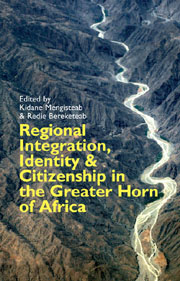Book contents
- Frontmatter
- Contents
- List of Tables, Figures & Appendices
- Notes on Contributors
- Acknowledgements
- List of Acronyms
- Part One RELEVANCE OF INTEGRATION TO IDENTITY AND CITIZENSHIP
- 1 Relevance of Regional Integration in the Greater Horn Region
- 2 Re-conceptualizing Identity, Citizenship and Regional Integration in the Greater Horn Region
- 3 A Diversity Perspective on Identity, Citizenship and Regional Integration in the Greater Horn of Africa
- Part Two CRITICAL FACTORS IN INTEGRATION
- Part Three LESSONS FROM SELECTED AFRICAN INTEGRATION SCHEMES
- Index
- EASTERN AFRICAN STUDIES
2 - Re-conceptualizing Identity, Citizenship and Regional Integration in the Greater Horn Region
from Part One - RELEVANCE OF INTEGRATION TO IDENTITY AND CITIZENSHIP
Published online by Cambridge University Press: 05 February 2013
- Frontmatter
- Contents
- List of Tables, Figures & Appendices
- Notes on Contributors
- Acknowledgements
- List of Acronyms
- Part One RELEVANCE OF INTEGRATION TO IDENTITY AND CITIZENSHIP
- 1 Relevance of Regional Integration in the Greater Horn Region
- 2 Re-conceptualizing Identity, Citizenship and Regional Integration in the Greater Horn Region
- 3 A Diversity Perspective on Identity, Citizenship and Regional Integration in the Greater Horn of Africa
- Part Two CRITICAL FACTORS IN INTEGRATION
- Part Three LESSONS FROM SELECTED AFRICAN INTEGRATION SCHEMES
- Index
- EASTERN AFRICAN STUDIES
Summary
INTRODUCTION
Identity is one of the most contested issues in social sciences (Brubaker and Cooper, 2000; Voros, 2006). It is also one of the profound and powerful factors behind some of the cruel conflicts in the Greater Horn of Africa region (GHR). Conflicts have been raging for several decades throughout the region that are thought to be stemming from real or imagined divisions and differences of identity. It is to be noted that the identity formation in the region is yet in the process of formation and transformation, thus both continuity and change are the defining features. This incompleteness of the formation process is one of the primary underlying causal factors for the identity-based conflicts and wars. How we define our identity and how we position and accommodate concomitant interests supposedly emanating from that perception determine relations between communities. The characterizing constituent identity features of the societies of the GHR region are poly-ethnic, polyglot and poly-religious. These social variables and pluralities in identities render the societies of the region ripe for potential conflict. To this could be added the predisposition of elites to utilize the multiplicity of identities constituting these societies for political expediency. All this coupled with other socio-economic factors have rendered the region the most conflict-ridden part of the continent (Shinn, 2008, 2009; Young, 2007; Cliffe, 2004; Woodward, 1994).
- Type
- Chapter
- Information
- Publisher: Boydell & BrewerPrint publication year: 2012



